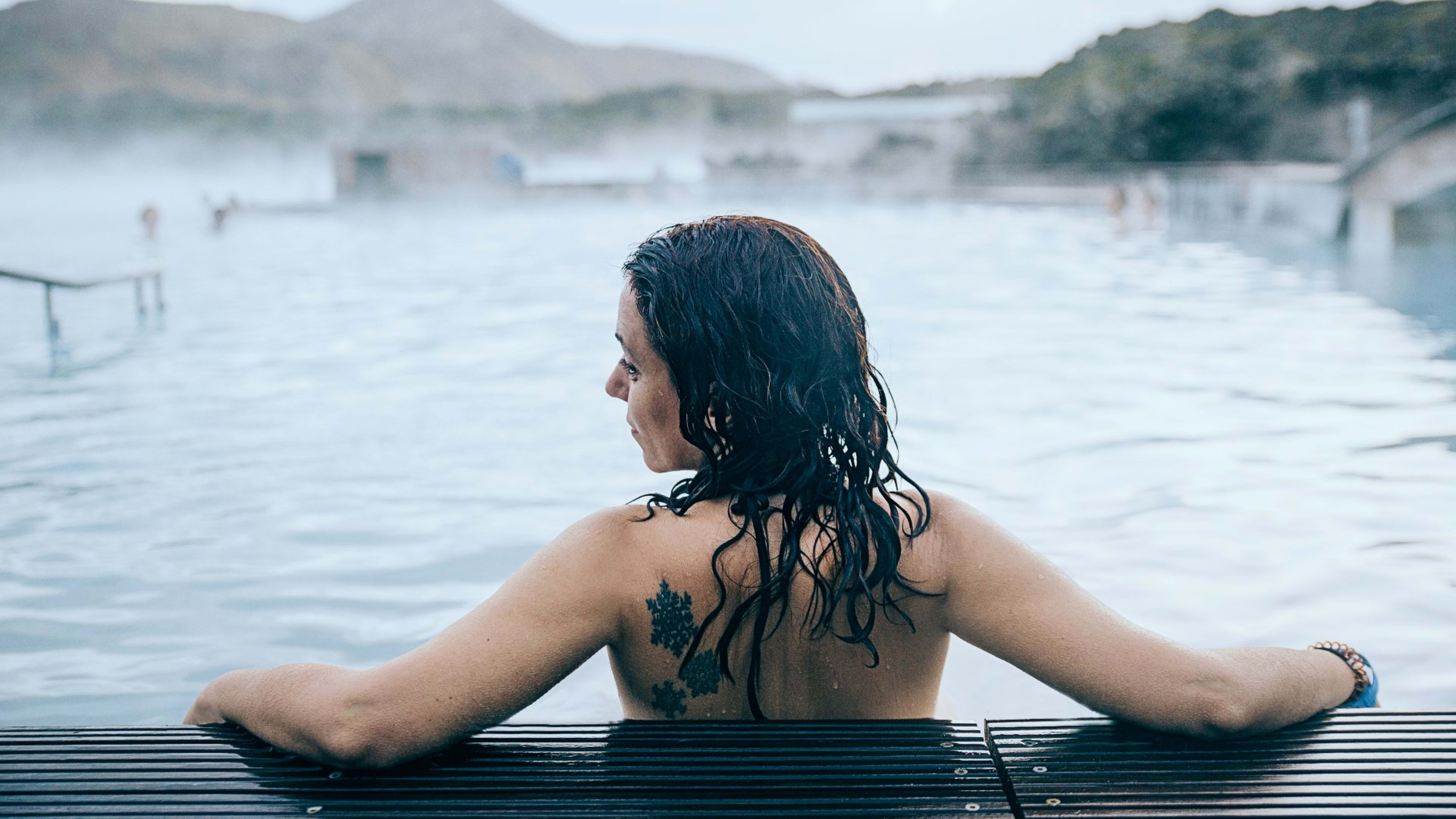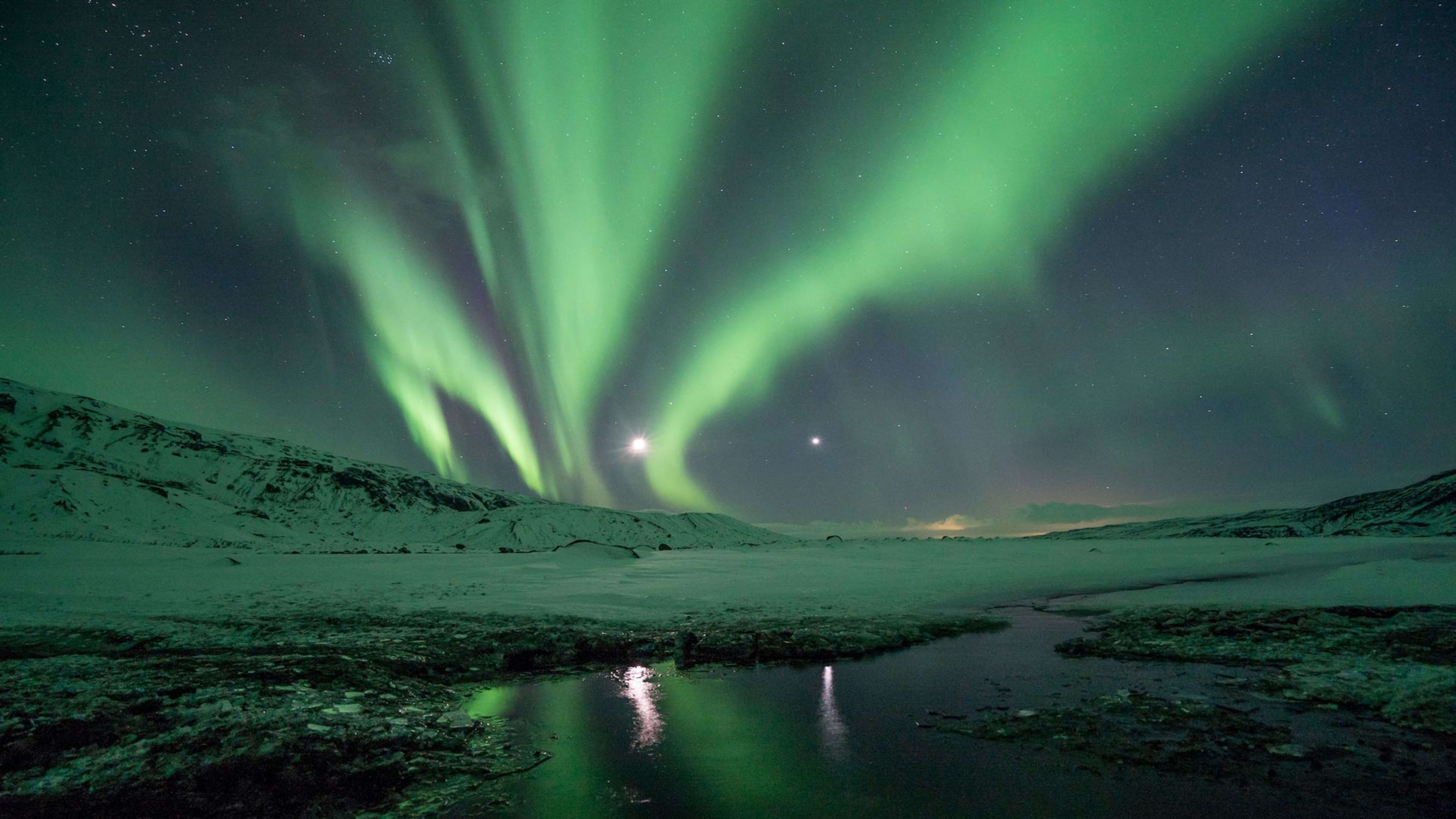On a trip to Iceland in January, you can ring in the New Year Icelandic-style under the fireworks! At this time of the year, the country is blanketed in a white winter coat. Picture frosted waterfalls, snow-covered mountaintops, and frozen rivers.
Winter may not seem like the most obvious time to visit. However, there are actually a bunch of top things to do in Iceland in January.
Apart from the New Year’s festivities, there’s the Þorrablót festival at the end of the month (or in early February). This movable feast is based on Viking traditions. (Keep reading to learn all about this unique celebration.)
January is a great time to experience Iceland without the crowds. Nature is open all year round, so you can still get your fill of gushing geysers and glistening glaciers. When you travel in January to Iceland, you’ll also have a great chance of seeing the Northern Lights.
Get inspired for your Iceland winter trip with these top tips!
Is It Worth Going to Iceland in January?
For sure. Iceland offers a whole host of unique experiences at the start of the year.
If you fancy doing something different for New Year’s, travel to Reykjavík in January. The whole city celebrates with firework displays and neighborhood bonfires, and the atmosphere is electric. And of course, there’s the epic nightlife that Iceland’s capital is famous for.
- Browse these winter tours of Iceland.
- Prefer to visit in November or December?
Next, there’s the Northern Lights. Although January offers slightly more daylight than December, there are still long, lingering periods of darkness. This creates the ideal conditions for hunting down the Aurora Borealis. Learn more about how to chase them down with our Northern Lights guide.
In the winter months, chances are there will be snow on the ground. Besides giving you the perfect backdrop for your vacation pics, the snow brightens everything up. This helps make up for the relative lack of sunlight.
Here are some of our favorite reasons to visit Iceland in winter:
- Fantastic conditions for Northern Lights tours
- More daylight than December, so you can go further and see more
- Frozen wintry landscapes covered in snow and ice
- Cultural events to enjoy at the start and end of the month
Best Things To See and Do in Iceland in January
Traveling to Iceland in January is fantastic for experiencing the country at the peak of its winter beauty. At this time of year, you’ll often find snow-covered mountains and icicle-draped waterfalls.

Things to do in Iceland in January:
- Warm up in a geothermal spa as the snow falls around you
- Visit the Jökulsárlón glacial lagoon surrounded by snowy scenery
- Go on a whale watching boat tour from Reykjavík
- Hunt down the Aurora Borealis at night
- See the Strokkur geyser erupt out of a field of ice
- Meet and ride an Icelandic horse on a snow-white field
- Walk through clouds of steam at the Deildartunguhver hot springs
- Go glacier hiking at Vatnajökull, Europe’s largest ice cap
- Join an ice cave tour beneath a glacier
- Marvel at the wintry landscapes on a snowmobiling tour
- Savor delicious Icelandic food
Get more inspiration with our Iceland winter must-sees and must-dos guide.
Best Places To Visit in Iceland in January
1. Akureyri

Location: North Iceland, 4–5 hours’ drive from Reykjavík.
Why visit? Akureyri is the capital of Iceland’s north and the country’s second city. Explore its charming old town, dine at its delicious restaurants, and soak up Icelandic culture in the galleries and museums. Oh, and if beer’s your thing, don’t forget to try Einstök, the local brew!
- See the northern capital & its surroundings on a North Iceland & Akureyri tour.
Just outside Akureyri is one of Iceland’s main ski resorts, Hlíðarfjall. There’s a good chance of snowfall in Iceland in January, with the month falling in the middle of ski season. So if you feel most at home on the slopes, why not head up to Akureyri?
Don’t miss: The Hof Culture House, Akureyri’s answer to Reykjavík’s famous Harpa Concert Hall. Also, make sure to visit the local pool for a relaxing dip in the hot tubs!
2. Vatnajökull National Park
Location: Southeast Iceland.
Why visit? Okay, we admit that Vatnajökull National Park ends up on pretty much all of our month-by-month guides to Iceland. But that’s just because it’s so unmissable. First up, you have Jökulsárlón glacier lagoon, which is spectacular at this time of year (especially in the long twilight).
- Visit Vatnajökull National Park on one of these guided group tours.
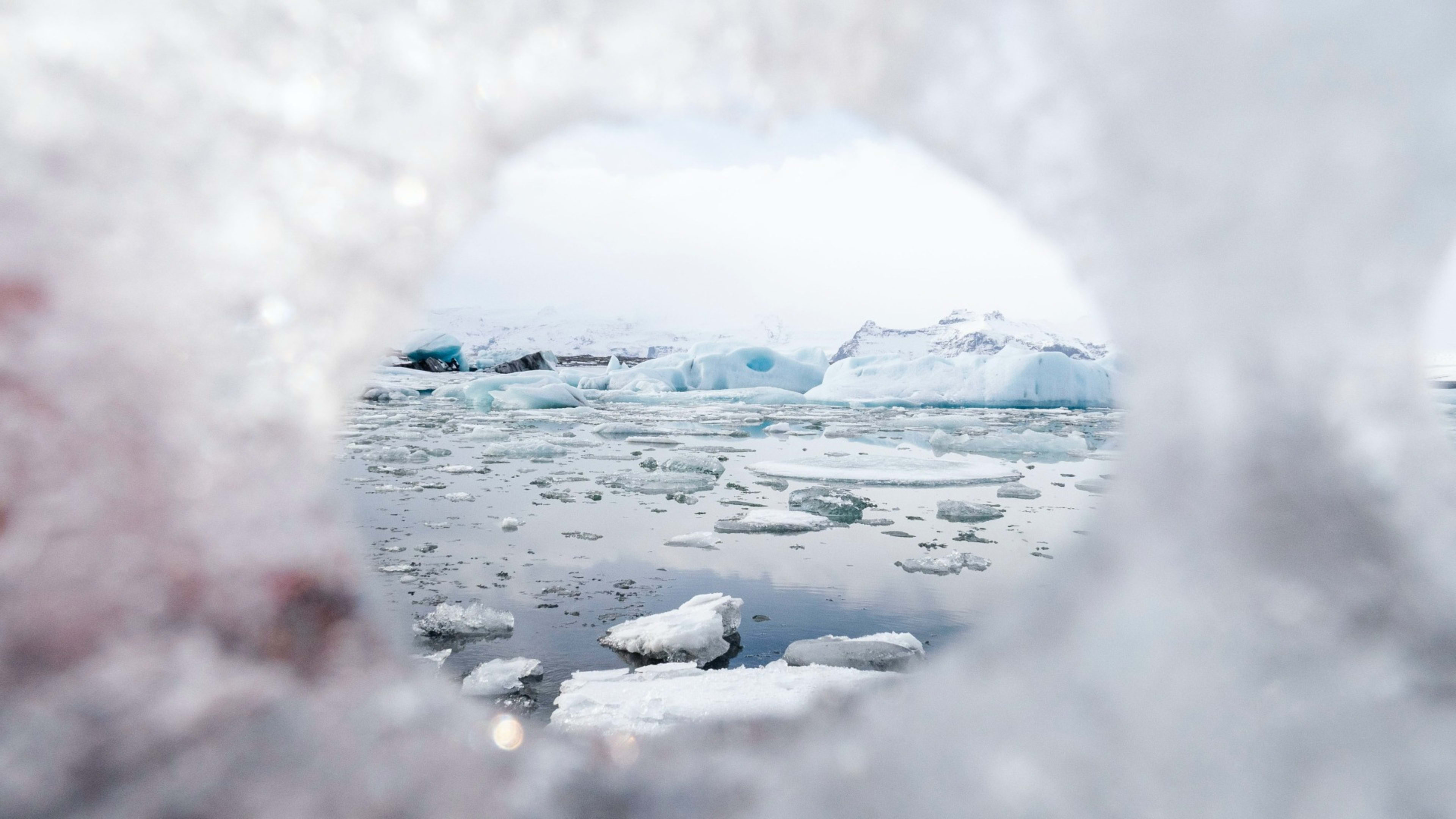
Then there’s the Vatnajökull glacier itself. The largest ice cap in Europe, it offers all kinds of adventure-packed experiences. Enjoy snowmobiling tours or hikes on the surface, or explore one of the ice caves that form underneath during winter. Vatnajökull is always a highlight of winter tours in Iceland, and January is the perfect time to experience it.
- Get active in winter on one of these Iceland adventure tours.
Don’t miss: Fellsfjara, also known as Diamond Beach. Here, brilliant chunks of blue-tinged, crystal-clear ice wash ashore, glittering like scattered jewels against the dark black sand.
3. Seljalandsfoss and Skógafoss Waterfalls

Location: South Coast, 1 hour or so from the town of Selfoss.
Why visit? These are two of Iceland’s most famous waterfalls. Striking in their winter costumes, these cascades stand out as unforgettable natural spectacles when you visit Iceland in January.
Seljalandsfoss is often crowned with icicles, and the mist from the falls freezes into a glistening sheet of ice behind it. Depending on the snowfall conditions, you may still be able to follow the path and walk behind the waterfall.
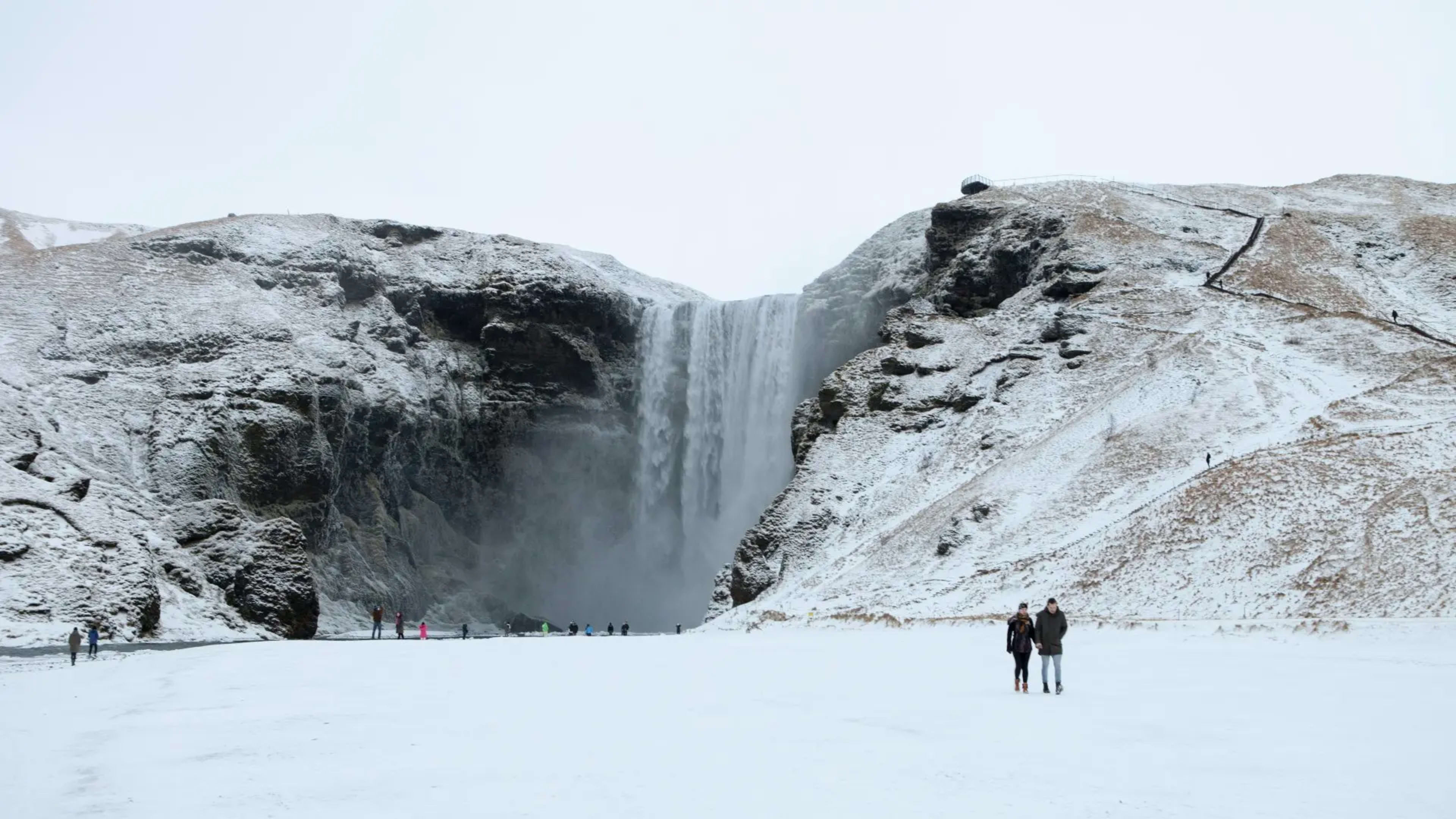
Skógafoss is Seljalandsfoss’s more powerful big brother. Often completely hemmed in by blue-white ice in wintertime, you won’t want to miss its wintry majesty.
Don’t miss: Gljúfrabúi, a virtually hidden waterfall a 10-minute drive up the road from Seljalandsfoss.
4. Golden Circle, including Þingvellir National Park
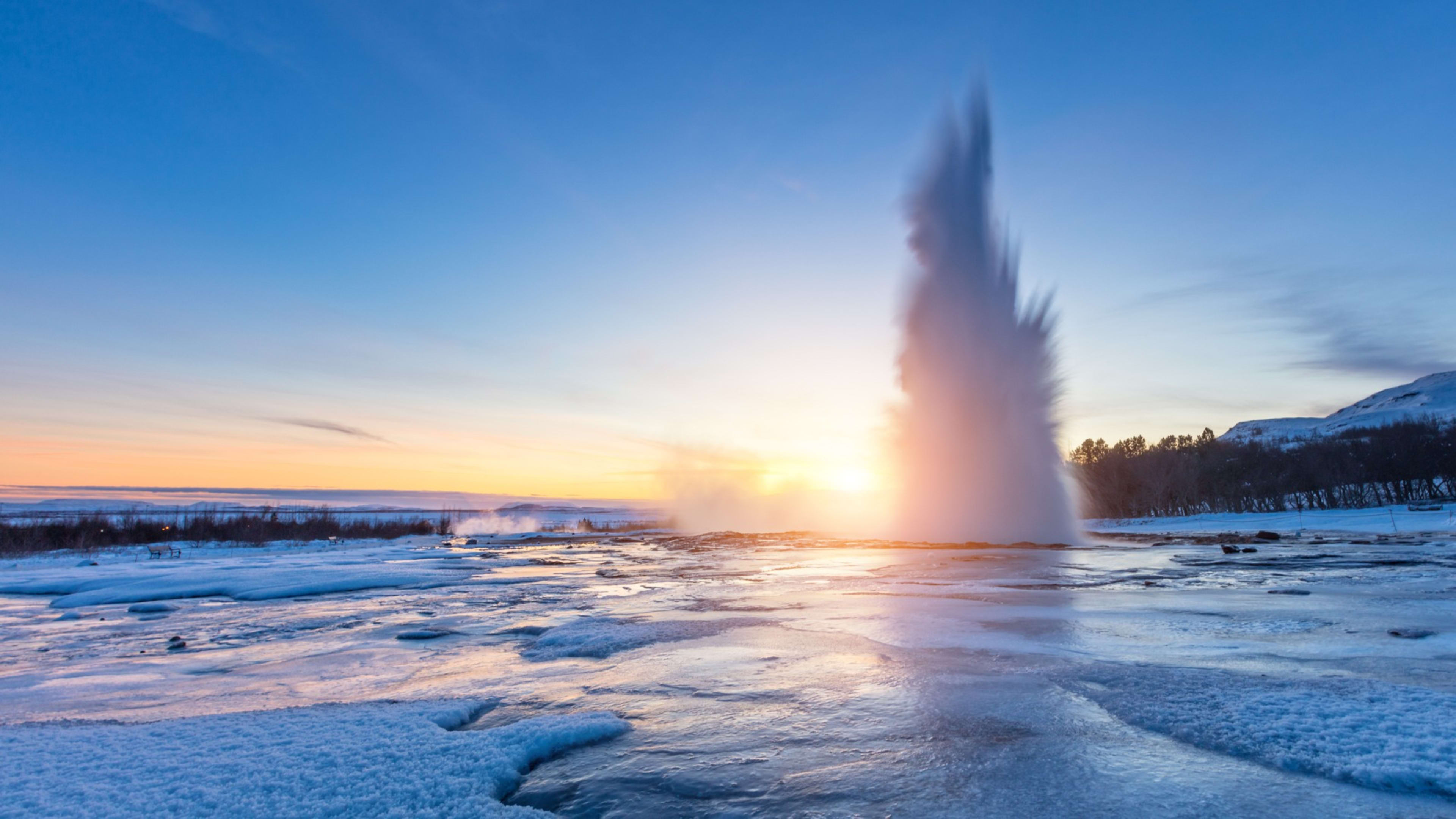
Location: 1 hour’s drive east of Reykjavík.
Why visit? The Golden Circle route is a popular classic and remains accessible all year round. It includes the Geysir area, with Strokkur, a live geyser that spurts hot water into the air every few minutes. Another star attraction is the epic multi-tiered Gullfoss waterfall.
Finally, there’s Þingvellir (Thingvellir) National Park. As the original site of Iceland’s Viking-era parliament, it’s a remarkable place to envision local life centuries ago. When visiting this historic site in Iceland in January, its massive, rocky gorges are caked in ice and snow. Even the small streams that criss-cross the area are frozen solid, creating a magical winter sight.
- Browse self-drive trips that include the Golden Circle.
- Blog: Your complete guide to Iceland’s Golden Circle.
Don’t miss: At Þingvellir, visit the Drekkingarhylur pool where witches were drowned, and the Silfra gorge with its crystal-clear waters.
5. Blue Lagoon and other spas
Location: ½ hour from Reykjavík (Blue Lagoon); around the country (other spas).
Why visit? Although the Icelandic weather in January can be bitterly cold, its endless supply of geothermal hot water offers a welcome comfort. Bathe in the warm and nourishing waters of the Blue Lagoon to relax and recharge after a day’s sightseeing.

There have never been more spa options in Iceland than right now. Instead of the Blue Lagoon, you can visit the new Sky Lagoon near the capital, with fantastic sea views. Alternatively, there’s the Fontana spa in Laugarvatn, just off the Golden Circle route.
And if you’re heading north to Akureyri, the Mývatn Nature Baths are just around an hour’s drive away. The spa sits over a picturesque valley, offering stunning views for guests to enjoy while soaking.
Wherever you plan to travel in Iceland, you’re not far from a fantastic lagoon or local swimming pool! A warm bath is definitely one of the most relaxing things to do in Iceland in January (or any time, really).
- Get the low-down on Icelandic bathing with our guide to hot springs and geothermal pools.
Don’t miss: A drink from one of the in-lagoon bars available at many of Iceland’s most popular spas.
Events in Iceland in January
Although the sun doesn’t show its face for long in January, Icelanders brighten the month with big celebrations. And of course, you get to take part!
New Year’s
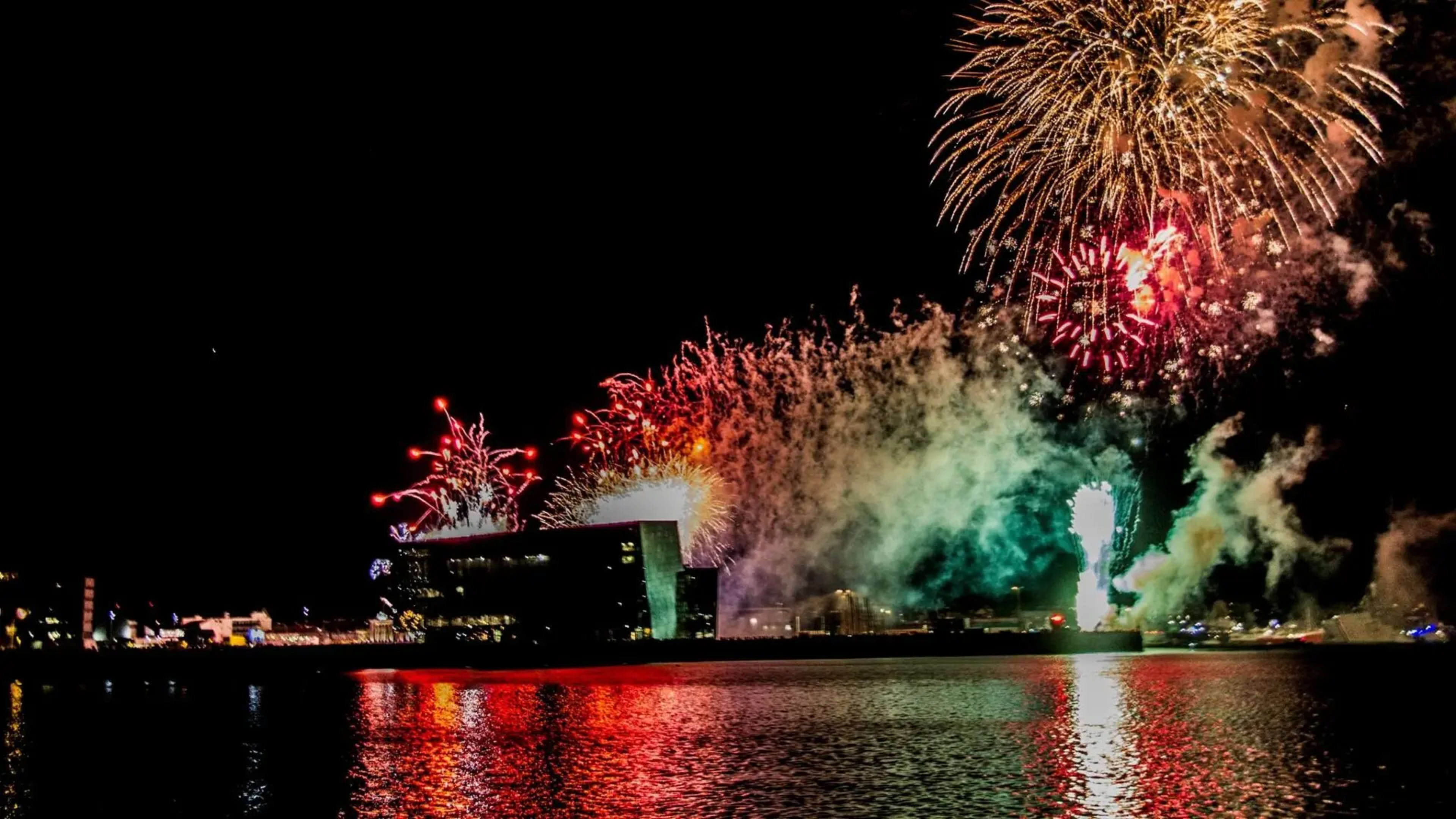
It’s fair to say that New Year’s is a big deal in Iceland. There are massive firework displays, bonfires throughout towns and cities, and a great festive atmosphere. Don’t miss the main display down by the Harpa Concert Hall in Reykjavík’s old harbor.
Icelanders kick off their New Year’s celebrations with dinner at around 6 p.m. These festivities are among the most popular events in Iceland in January. Many people enjoy some kind of roast meat, such as leg of lamb or goose. It’s worth securing a booking at a local restaurant if you want to join in on this tradition.
- Want to join the festivities? Check out these Iceland New Year’s packages.
After dinner (and plenty of desserts), do as the locals do and visit a local bonfire. Later on, Icelanders watch New Year’s addresses from the prime minister and president, before getting into the party mood.
With a belly full of good food, now’s the time to head out to a local bar before watching the fireworks at midnight. Whether you party on is up to you, but you can be sure that the locals will!
Þrettándinn (The Thirteenth of Christmas)
Many countries pack up their decorations on New Year's Day. In Iceland, locals wait until January 6th for Þrettándinn, or the Thirteenth Day of Christmas.
Rounding out the festive celebrations in Iceland during January is a truly unique and enchanting tradition. Þrettándinn marks the date when the final remaining Yule Lads return to their mountain homes. This day is also traditionally associated with folklore, when elves and hidden people are said to emerge and dance.
Expect bonfires and stunning fireworks displays, similar to New Year's Eve, particularly in smaller towns. The charming blend of fire and folklore offers a spectacular end to the Christmas season.
For travelers intrigued by myths and magic, Þrettándinn also provides a glimpse into the tales woven into the Icelandic winter landscape.
Learn more about Icelandic elves, trolls, and monsters.
Þorrablót

Like many other nations, Icelanders have their own midwinter festival held around the end of January (and sometimes in February). The feast, known as Þorrablót (or 'Thorrablót'), marks the first of the four months on the Norse pagan calendar: Þorri.
Although based on ancient Viking tradition, Þorrablót first began to be celebrated in the 19th century. It has become increasingly popular in recent decades. Similar to Scotland’s Burns Night, Þorrablót centers on sharing traditional food and reciting poems.
It’s that traditional food, known as Þorramatur, that is the highlight (or lowlight, depending on your view) of the festival. Icelandic delicacies enjoyed during Þorrablót include:
- Kæstur hákarl – fermented shark with a pungent smell (pictured above, the yellow cubes on the right)
- Hrútspungar – ram’s testicles pressed and preserved in aspic
- Svið – singed and boiled sheep’s head, complete with eyeball
- Lifrarpylsa – a lamb-based liver sausage
- Blóðmör – a type of black pudding
- Hangikjöt – smoked slices of lamb
- Harðfiskur – wind-dried cod or haddock, served buttered (pictured above, the white fluffy fish in the middle)
Before passing judgment on these traditional (albeit unconventional) treats, know that several are quite popular among visitors and Icelanders alike. It’s definitely worth trying hangikjöt and harðfiskur, even if you skip everything else.
Look out for Þorramatur buffets at restaurants around Reykjavík. That way, you can sample what you like and be as adventurous as you want to be!
- Learn more about what to eat with our Iceland food guide.
Dark Music Days
If you are looking for cultural events in Iceland in winter, consider the renowned Dark Music Days (Myrkir Músíkdagar). Held annually in Reykjavík, this festival showcases the very best of Icelandic and international contemporary and new music.
Running since 1980, Dark Music Days presents a diverse program in venues like Harpa Concert Hall. It makes the most of the city’s stunning winter backdrop, filling the long evenings with diverse tunes.
For anyone seeking an authentic cultural experience, attending this festival is a memorable activity in Reykjavík, Iceland in January.
The Reykjavik International Games
Meanwhile, travelers interested in local sports can check out the Reykjavík International Games (RIG). Among the most exciting sporting events in Iceland in January, this multi-sport competition attracts top international and national competitors.
The RIG is held over a number of days and features a diverse lineup of competitions. Events range from traditional sports like swimming, track and field, and gymnastics, to more specialized disciplines such as judo and powerlifting.
The event is hosted primarily at the Laugardalur Sports Center. It gives visitors a wonderful opportunity to see world-class athletes compete across dozens of events.
What’s the Weather in Iceland in January?
January is often Iceland’s coldest month, although you might be surprised by how mild the temperatures actually are. The average high in the south is 3°C (38°F), and the average low is -2°C (29°F). Knock a degree or two off for the north of Iceland.
The wind chill factor can make it feel much colder than the thermometer suggests, though. With that in mind, make sure you pack a warm winter coat, extra layers, gloves, a scarf, and a woolly hat.
Don’t bother with umbrellas or baseball caps; you probably won’t be able to hold onto them long in the wind!
Learn more about the country’s conditions with our guide on Iceland’s weather and climate.
Is There Snow in Iceland in January?
There’s also a good chance of snow in January, especially outside of Reykjavík. Across the whole month, average snowfall is around 20 cm (8 in).
Is It Safe To Drive in Iceland in January?
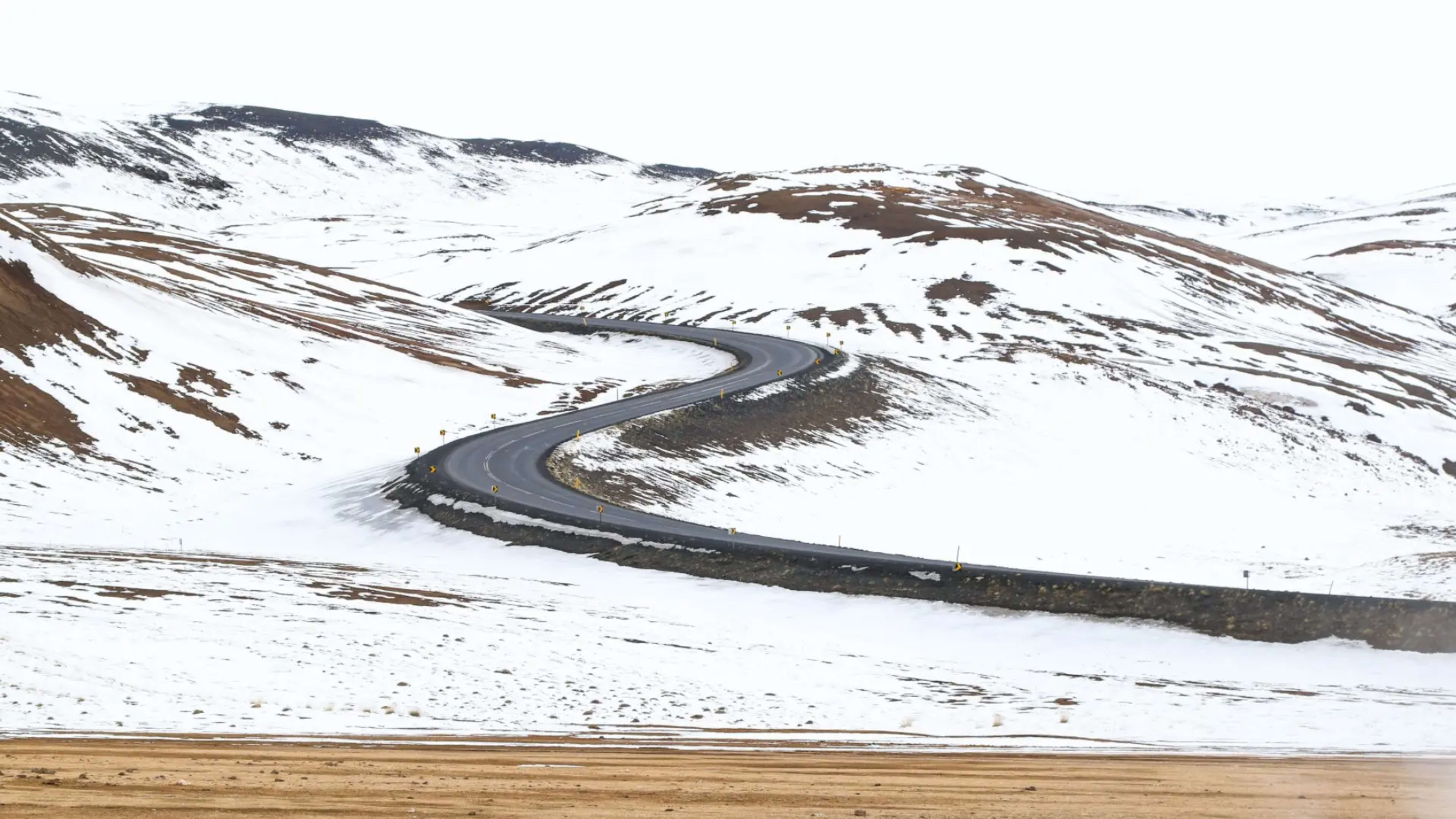
As January is a month of significant snowfall, driving conditions can be trickier, especially with Iceland’s famous winter winds. That said, trunk roads are cleared regularly. In cities, most major roads will be snow-free.
As conditions can change rapidly, it pays to be flexible with your plans. Shorter day trips, such as the Golden Circle or South Coast, are advised.
So whilst driving in January in Iceland is doable, we wouldn’t recommend it if you’re not a confident winter driver. Alternatively, enjoy a city break in Reykjavík with day trips by bus if you’d prefer to skip the driving.
Are the Roads Open in Iceland in January?
This is one of the most important questions when planning to visit Iceland in winter. The short answer is: Yes, the major routes are open, but not all roads are.
The Ring Road (Route 1), which circles the entire country, remains open and accessible throughout the winter months. Road services in Iceland prioritize keeping this and all primary routes to major settlements clear of snow and ice.
All mountain and highland roads, known as F-Roads, are closed during the winter in Iceland. Access to the deep interior is restricted to specialist guided tours only.
Expect the unexpected when driving in Iceland in winter. Due to heavy snowfall, extreme winds, or blizzards, sections of the Ring Road and secondary roads can be closed temporarily for safety. These closures can last for hours or, in rare cases, a day or two.
How Many Hours of Daylight Are There in Iceland in January?
By the time January comes around, the days are already getting noticeably longer. Daylight hours in Iceland in January range approximately 4.5 to 7 hours, increasing throughout the month.
At the start of January, the sun rises at around 11:20 a.m. and sets by around 3:45 p.m. By the end of the month, the sun appears as early as 10:10 a.m. and goes down at approximately 5:10 p.m.
So as you can see, you gain a few extra hours of daylight over the space of just a few weeks. This is worth bearing in mind when choosing your travel dates.
Can You See the Northern Lights in Iceland in January?
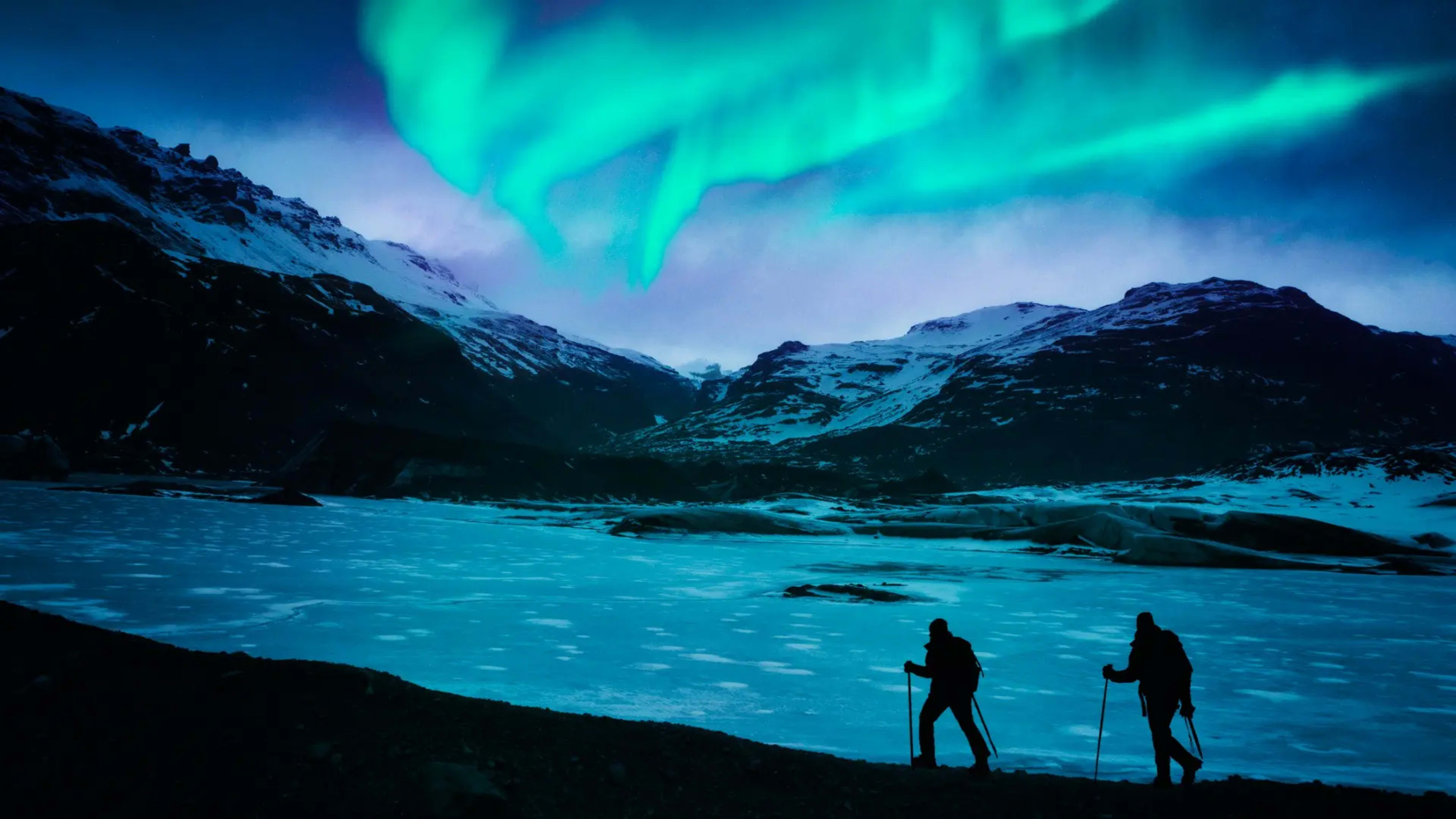
Absolutely! January provides ideal conditions for chasing down the lights. The 3 things you need are plenty of darkness, clear skies, and high solar activity. If these things coincide, then you’ll witness a spectacular light show.
- Check out these Northern Lights tours of Iceland.
- Blog: Best places to see the Northern Lights in Iceland.
The good news is that January provides darkness in spades. And as the Icelandic weather never stays the same for long, there’s a good chance you’ll have at least one clear night during your stay.
You should know, though, that the Northern Lights are a natural phenomenon. Thus, even if the weather’s in your favor, you’re not guaranteed a sighting. Part of the attraction is their mystery and rarity, which makes chasing them down all the more exciting!
Get tips on how to spot the aurora with our guide to the Northern Lights in Iceland.
What To Wear and What To Pack for a Trip to Iceland in January?
Since January falls right in the middle of the Icelandic winter, it’s important to make sure you bring everything you need to keep warm and comfortable. As we mentioned earlier, the wind chill can make it feel much colder than it might seem.
The wind tends to be chilly and dry, but that’s nothing that you can’t protect yourself from with the right clothing! Here’s a list of essentials to take to Iceland in winter:
- Warm jacket with a waterproof layer
- Woolen sweaters or fleeces
- Gloves, scarf, and woolly hat
- Solid hiking boots and thermal socks
- Warm underwear, such as long johns
- Swimming gear and a towel for spas, hot springs, and pools
- Lip salve and moisturizer
Read our packing guide to get all the deets on what to bring on a January trip to Iceland.
Planning Your Trip to Iceland in January
Now that you’re in the know, how do you go about making your dream vacation to Iceland in January a reality? First, decide if you want to attend any festivals such as New Year’s and Þorrablót. This will help you narrow down your dates.
- Can’t decide how many days you need in Iceland in winter?
Secondly, think about what kind of activities you want to do and which parts of the country you want to see. From aurora chasing to glacier hikes, there are plenty of exciting things to do in Iceland in January. The further you venture from Reykjavík, the more important it becomes to schedule your activities efficiently around the limited sunlight.
At Iceland Tours, we’ve got a wide range of winter vacation packages. If you’re happy to drive in wintry conditions, choose a self-drive tour. Otherwise, go for a convenient multi-day tour from Reykjavík if you prefer to travel by bus from the capital daily.
Once you’ve found the winter tours in Iceland that suit you, simply book them online. A great thing to know is that you can secure your booking with us with just a 5% deposit. With our Book with Confidence promise, you can get a refund or rebook your tour should unforeseen circumstances get in the way of your plans.
Ready to visit Iceland in January and experience the Land of Fire and Ice at its wintriest?


